Zoom
Trash

Alexander Selkirk. Alexander Selkirk (1676 – 13 December 1721), also known as Alexander Selcraig, was a Scottish sailor who spent more than four years as a castaway after being marooned on an uninhabited island in the South Pacific Ocean.
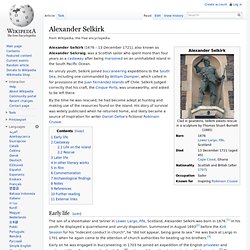
By the time he was rescued, he had become adept at hunting and making use of the resources found on the island. His story of survival was widely publicised when he returned home, and likely became a source of inspiration for writer Daniel Defoe's fictional Robinson Crusoe. Early life[edit] The son of a shoemaker and tanner in Lower Largo, Fife, Scotland, Alexander Selkirk was born in 1676. In his youth he displayed a quarrelsome and unruly disposition. In February 1704, following a stormy passage round Cape Horn, the privateers fought a long battle with a well-armed French vessel, the St Joseph, only to have it escape to warn the Spanish of their arrival in the Pacific. Castaway[edit] Alexander Selkirk Feature Page on Undiscovered Scotland. Alexander Selkirk, or Alexander Selcraig, lived from 1676 to 13 December 1721).
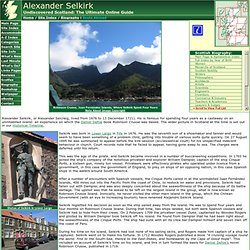
He is famous for spending four years as a castaway on an uninhabited island: an experience on which the Daniel Defoe book Robinson Crusoe was based. The wider picture in Scotland at the time is set out in our Historical Timeline. Selkirk was born in Lower Largo in Fife in 1676. He was the seventh son of a shoemaker and tanner and would seem to have been something of a problem child, getting into trouble of various sorts quite quickly. On 27 August 1695 he was summoned to appear before the kirk-session (ecclesiastical court) for his unspecified indecent behaviour in church. Alexander Selkirk: Part 1. By James S.
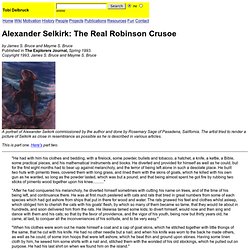
Bruce and Mayme S. Bruce Published in The Explorers Journal, Spring 1993. Copyright 1993, James S. Bruce and Mayme S. Bruce. The Solitude of Alexander Selkirk. Now available in the Damn Interesting fragrance department: Ben Taylor's "New Writer Scent.
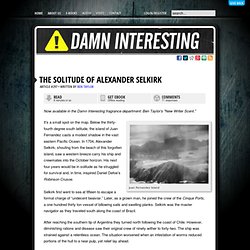
" Juan Fernandez Island It’s a small spot on the map. Alexander Selkirk - The Kingdom Of Fife. Robinson Crusoe is a very popular fictional autobiography first published in 1719.It was written by Daniel Defoe and most likely influenced by the real-life Alexander Selkirk, a Scottish castaway who lived four years on a Pacific island called "Más a Tierra" and where, in 1966, its name was changed to Robinson Crusoe Island.

Alexander Selkirk was born in Lower Largo, the son of a shoemaker and tanner in 1676. In his youth he displayed a quarrelsome and unruly disposition and was summoned to appear before the Kirk Session on 27 August 1695 but ran off to sea before that date. He became engaged in buccaneer expeditions to the South Seas and joined with the expedition of the famous privateer and explorer William Dampier in 1703. While Dampier captained the 'St George', Selkirk served on the galley 'Cinque Ports' often sailing alongside under command of Thomas Stradling. Ultimately, his clothing became that taken from the goats and sewn using a nail. History - Scottish History. Lower Largo - home to Alexander Selkirk's Robinson Crusoe. The Real Robinson Crusoe. Juan Fernández Islands. The Juan Fernández Islands (Spanish: Archipiélago Juan Fernández) are a sparsely inhabited island group reliant on tourism and fishing in the South Pacific Ocean.
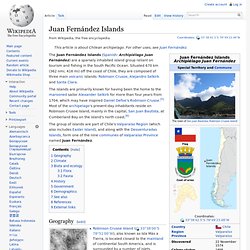
Situated 670 km (362 nmi; 416 mi) off the coast of Chile, they are composed of three main volcanic islands: Robinson Crusoe, Alejandro Selkirk and Santa Clara. The islands are primarily known for having been the home to the marooned sailor Alexander Selkirk for more than four years from 1704, which may have inspired Daniel Defoe's Robinson Crusoe.[5] Most of the archipelago's present-day inhabitants reside on Robinson Crusoe Island, mainly in the capital, San Juan Bautista, at Cumberland Bay on the island's north coast.[6] The group of islands are part of Chile's Valparaíso Region (which also includes Easter Island), and along with the Desventuradas Islands, form one of the nine communes of Valparaíso Province named Juan Fernández.
Geography[edit] Climate[edit] Biota and ecology[edit] Flora[edit] Fauna[edit] History[edit] Robinson Crusoe Island. Robinson Crusoe Island (Spanish: Isla Robinson Crusoe), formerly known as Más a Tierra (Closer to Land),[3] is the second largest of the Juan Fernández Islands, situated 670 km (416 mi) west of San Antonio, Chile, in the South Pacific Ocean.
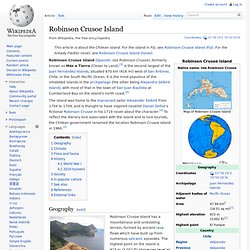
It is the most populous of the inhabited islands in the archipelago (the other being Alejandro Selkirk Island), with most of that in the town of San Juan Bautista at Cumberland Bay on the island's north coast.[2] The island was home to the marooned sailor Alexander Selkirk from 1704 to 1709, and is thought to have inspired novelist Daniel Defoe's fictional Robinson Crusoe in his 1719 novel about the character.[4] To reflect the literary lore associated with the island and to lure tourists, the Chilean government renamed the location Robinson Crusoe Island in 1966.[3] Geography[edit] Robinson Crusoe Island has a mountainous and undulating terrain, formed by ancient lava flows which have built up from numerous volcanic episodes.
Climate[edit] Buscando a Crusoe. Explore the oceans - BlooSee. Robinson Crusoe Island 2006 Field Trip Photos on Goat Island Images. Robinson Crusoe Island is located approximately 400 miles off the west coast of Chile.
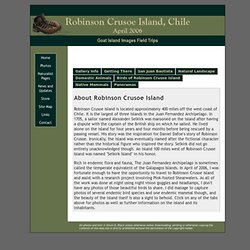
Robinson Crusoe, Moai statues and the Rapa Nui: the stories of Chile’s far-off islands By Mark Briggs - 18 October, 2010 There are few monuments more recognisable than the ‘heads’ of Easter Island.
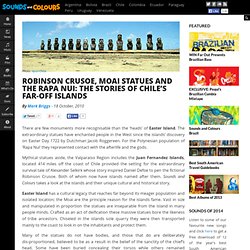
Apocalypse Island - Apocalypse Island. Landscape photos of Juan Fernandez Archipelago with Robinson Crusoe Island. Robinson Crusoe. Robinson Crusoe /ˌrɒbɪnsən ˈkruːsoʊ/ is a novel by Daniel Defoe, first published on 25 April 1719.
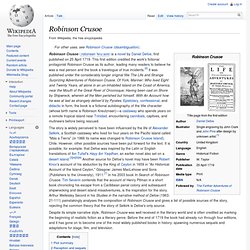
This first edition credited the work's fictional protagonist Robinson Crusoe as its author, leading many readers to believe he was a real person and the book a travelogue of true incidents.[2] It was published under the considerably longer original title The Life and Strange Surprizing Adventures of Robinson Crusoe, Of York, Mariner: Who lived Eight and Twenty Years, all alone in an un-inhabited Island on the Coast of America, near the Mouth of the Great River of Oroonoque; Having been cast on Shore by Shipwreck, wherein all the Men perished but himself. With An Account how he was at last as strangely deliver'd by Pyrates. Despite its simple narrative style, Robinson Crusoe was well received in the literary world and is often credited as marking the beginning of realistic fiction as a literary genre.
Plot summary[edit] Reception and sequels[edit] The book was published on 25 April 1719. The Life and Adventures of Robinson Crusoe (1808) by Daniel Defoe. Literapedia - Robinson Crusoe. Robinson Crusoe: Index. Robinson Crusoe: Plot Overview. Robinson Crusoe is an Englishman from the town of York in the seventeenth century, the youngest son of a merchant of German origin. Encouraged by his father to study law, Crusoe expresses his wish to go to sea instead. His family is against Crusoe going out to sea, and his father explains that it is better to seek a modest, secure life for oneself. Initially, Robinson is committed to obeying his father, but he eventually succumbs to temptation and embarks on a ship bound for London with a friend. When a storm causes the near deaths of Crusoe and his friend, the friend is dissuaded from sea travel, but Crusoe still goes on to set himself up as merchant on a ship leaving London. This trip is financially successful, and Crusoe plans another, leaving his early profits in the care of a friendly widow.
Crusoe soon learns he is the sole survivor of the expedition and seeks shelter and food for himself. One day Crusoe is shocked to discover a man’s footprint on the beach. Works - Criticism - SLM Literary Reviews (January 1836) Daniel Defoe, The Life and Surprising Adventures of Robinson Crusoe, of York, Mariner: with a Biographical Account of Defoe. Illustrated with Fifty Characteristic Cuts, from Drawings, by William Harvey, Esq. and engraved by Adams. New York: Published by Harper and Brothers. This publication is worthy of the Harpers. It is an honor to the country — not more in the fine taste displayed in its getting up, than as evincing a just appreciation of an invaluable work.
How fondly do we recur, in memory, to those enchanted days of our boyhood when we first learned to grow serious over Robinson Crusoe! Robinson Crusoe by Mary Godolphin. Ght. " He gave me a good round sum for my boat, and said that I should have the same sum for Xury, if I would part with him. But I told him that as it was by the boy's help that I had got free, I was loath to sell him. He said it was just and right in me to feel thus, but at the same time, if I could make up my mind to part with him, he should be set free in two years' time. So, as the poor slave had a wish to go with him, I did not say "no. " I got to All Saints' Bay in three weeks, and was now a free man.
I had made a good sum by all my store, and with this I went on land. I did not at all like this kind of life. Island gives up secret of real Robinson Crusoe - Top stories. A GLINT of metal in the soil marked the end of a 13-year quest by a Japanese explorer to locate the base camp of Alexander Selkirk, the marooned 18th-century mariner, whose ordeal inspired the book Robinson Crusoe. As a teenager, Daisuke Takahashi read the classic novel by Daniel Defoe and when he discovered it was based on the life of a Scottish sailor, an obsession was ignited which has carried him across the globe to the island of Mas-a-Tierra, 416 miles off the coast of Chile, where Selkirk was abandoned in 1704. An expedition led by Mr Takahashi has now uncovered clinching evidence of the location of Selkirk's base camp, where he spent four years and four months scanning the horizon in hope of rescue.
Trapped on a Pacific Island: Scientists Research the Real Robinson Crusoe. What was it he had seen? A fire burning on an uninhabited island in the South Pacific? The next day, the captain of the Duke, an English buccaneer ship, sent an armed party to the island to investigate. When the men returned to the ship, they brought along two surprises: large numbers of spiny lobsters and a shaggy creature. The figure that climbed on board the Duke on Feb. 2, 1709 was apparently human, but wild as an animal, barefoot and covered in goatskin. The creature, extremely agitated, was only able to stammer a few barely comprehensible words at first, but they were enough to become immortal.